
Springfield is a historic neighborhood of Jacksonville, Florida, United States, located to the north of downtown. Established in 1869, it experienced its greatest growth from the early 1880s through the 1920s. The Springfield Historic District is listed in the National Register of Historic Places, and contains some of the city's best examples of 19th and early 20th century architecture.
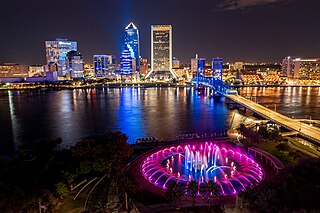
Downtown Jacksonville is the historic core and central business district (CBD) of Jacksonville, Florida. It comprises the earliest area of the city to be developed and is located in its geographic center along the narrowing point of the St. Johns River.

Ortega is a neighborhood of Jacksonville, Florida, US. It is located south of downtown Jacksonville on a peninsula off the western bank of the St. Johns River. It is one of the wealthiest neighborhoods in Jacksonville, and is the location of many historic homes and buildings.
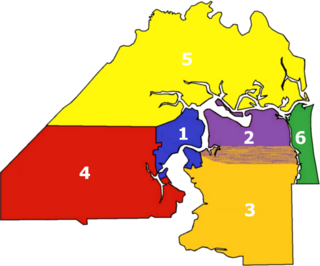
There are more than 500 neighborhoods within the area of Jacksonville, Florida, the largest city in the contiguous United States by area. These include Downtown Jacksonville and surrounding neighborhoods. Additionally, greater Jacksonville is traditionally divided into several major sections with amorphous boundaries: Northside, Westside, Southside, and Arlington, as well as the Jacksonville Beaches.

The Red Bank Plantation House is a historic former plantation house in Jacksonville, Florida. Built in 1854 as the main house for the Red Bank plantation, it is now a private residence within the Colonial Manor area of Jacksonville's San Marco neighborhood. It is located at 1230 Greenridge Road, and was added to the National Register of Historic Places on October 18, 1972.

Henry John Klutho (1873–1964) was an American architect known for his work in the "Prairie School" style. He helped in the reconstruction of Jacksonville, Florida after the Great Fire of 1901—the largest-ever urban fire in the Southeast—by designing many of the new buildings built after the disaster. This period lasted until the beginning of World War I. Several Jacksonville architects began their careers in the offices of Klutho's firm.

The former St. Andrew's Episcopal Church building, also known as Old St. Andrew's Event Venue, is an historic building located at 317 Florida Avenue in downtown Jacksonville, Florida. It was originally an Episcopal church, but closed when the parish relocated to the suburbs in 1960. On May 4, 1976, the edifice was added to the U.S. National Register of Historic Places. In the 1990s it was purchased by the City of Jacksonville and turned over to the Jacksonville Historical Society (JHS), and now serves as an event venue managed by the society.

The Lummus Park Historic District or simply Lummus Park, is on the National Register of Historic Places and a locally historic designated district in Miami, Florida. It is roughly bound by Northwest Fifth Street to the north, Flagler Street to the south, Northwest Third Avenue to the east, and the Miami River to the west. On October 25, 2006, it was added to the U.S. National Register of Historic Places. Lummus Park has some of the oldest structures in Miami, and over the decades, has been able to retain a large part of its early pioneer character.
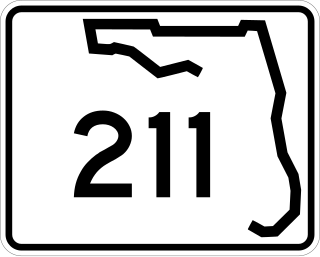
State Road 211 is a state highway entirely within Jacksonville, Florida, running from San Juan Avenue, north to Peninsular Place.
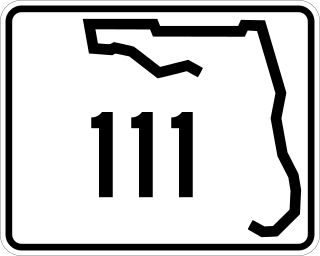
State Road 111 (SR 111) is a 11.875-mile-long (19.111 km) state highway in Jacksonville, within the northeastern part of the U.S. state of Florida. It travels from SR 21 in Lake Shore, heading north, then east to end at US 17 in Oceanway. The road is a four-lane highway for its entire length, with a median division in some segments.
Roosevelt Boulevard is a six lane highway on the west side of Jacksonville, Florida. It takes US 17 and SR 15, from the Duval county line just south Interstate 295, until its northern end at Willow Branch Avenue, with the road itself becoming one of the incarnations of College Street in the Riverside area of Jacksonville.

The Sun-Ray Cinema at 5 Points, formerly known as Riverside Theater and 5 Points Theatre, is a historic two-screen movie theater in Jacksonville, Florida. The first theater in Florida equipped to show talking pictures, it opened in March 1927 in the Five Points district of the Riverside and Avondale neighborhood.

Roy A. Benjamin (1887–1963) was a prominent architect who lived in Jacksonville, Florida.

Riverside Park is an 11.4-acre (46,000 m2) public park, located in the heart of Riverside, one of the most historic neighborhoods near downtown Jacksonville, Florida. It is the second oldest park in the city.

Brooklyn is a neighborhood of Jacksonville, Florida, considered part of the downtown area. Originally a residential suburb, commercial uses became prominent during the 20th century, particularly along the St. Johns River and Riverside Avenue, and the area became included in Jacksonville's central business district. In the 21st century, it has become the site of mixed-use developments.
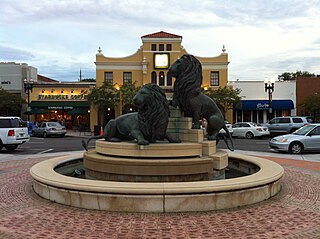
San Marco is a neighborhood of Jacksonville, Florida, south of Downtown across the St. Johns River. The neighborhood was formerly the independent city of South Jacksonville until it was annexed by Jacksonville in 1932. The neighborhood is primarily residential, with an integrated commercial sector known as San Marco Square.

The architecture of Jacksonville is a combination of historic and modern styles reflecting the city's early position as a regional center of business. According to the National Trust for Historic Preservation, there are more buildings built before 1967 in Jacksonville than any other city in Florida, though few structures in the city center predate the Great Fire of 1901. Numerous buildings in the city have held state height records, dating as far back as 1902, and last holding a record in 1981.

The Riverside Arts Market (RAM) of Jacksonville, Florida is a weekly arts-and-crafts market featuring live music, food, art, and fresh produce. It first opened to the public in the spring of 2009 and currently opens every Saturday 10AM-3PM ET rain or shine, year-round. The marketplace includes a 350-person amphitheater known as Northbank Riverwalk Artists’ Square and forms the terminus for the Northbank Riverwalk. It is located underneath the Fuller Warren Bridge alongside the St. Johns River.
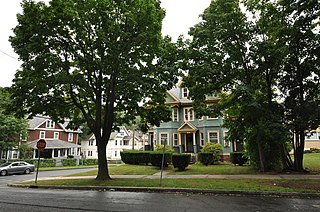
The Sisson-South Whitney Historic District encompasses a neighborhood in the West End area of Hartford, Connecticut, that was built out between 1890 and 1930 as a streetcar suburb. It is roughly bounded by Farmington Avenue, South Whitney Street, West Boulevard, and Sisson Avenue, and includes a diversity of residential and commercial architecture, reflective of its initial development and subsequent growth. The district was listed on the National Register of Historic Places in 2013.
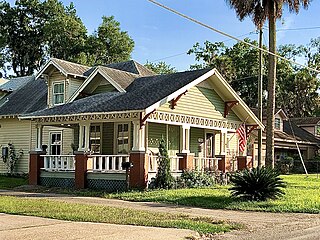
Tallulah-North Shore, or simply North Shore, is a neighborhood of Jacksonville, Florida located in the Northside area. First platted in 1879, the primarily residential area was annexed by Jacksonville in 1925. The Trout River, a tributary of the St. Johns River, is North Shore's most notable feature and also forms the neighborhood's northern border.



























